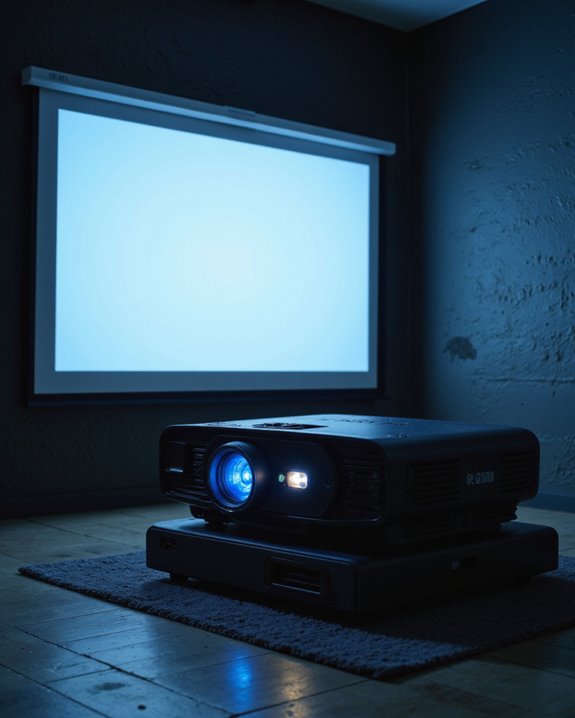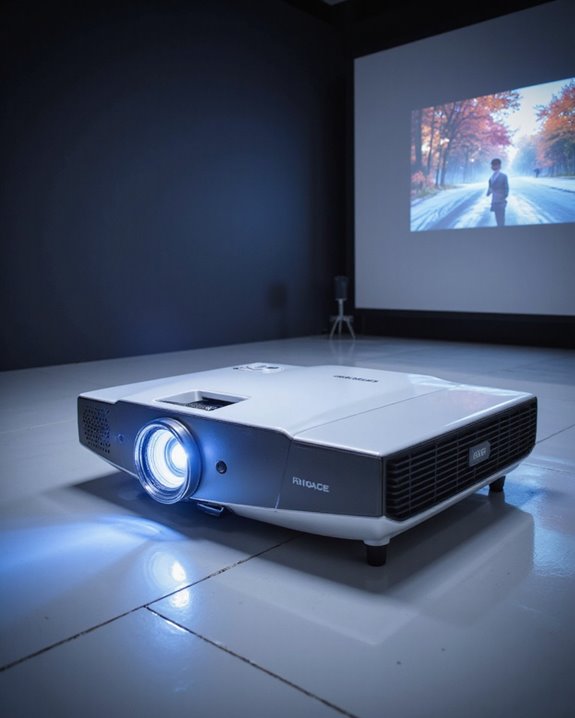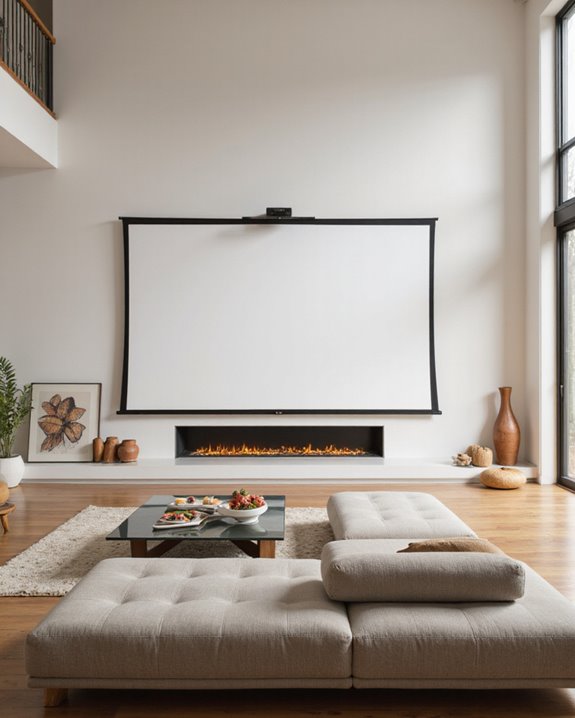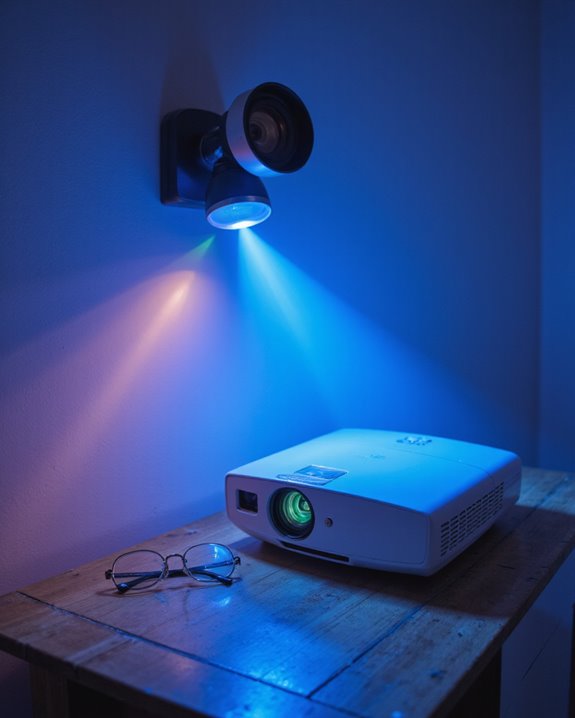Projectors do not require WiFi to function effectively, as they can operate through traditional HDMI, VGA, or USB connections. WiFi capability adds convenient features like wireless streaming from phones and tablets, smart device integration, and access to entertainment apps like Netflix. Modern WiFi-enabled projectors support technologies such as Miracast and AirPlay, while maintaining compatibility with standard wired connections. Understanding the full range of connectivity options helps users maximize their home theater experience.
Key Takeaways
- Projectors do not require WiFi for basic functionality, as they can operate effectively through traditional connections like HDMI, VGA, or USB-C.
- WiFi capabilities enhance convenience by enabling wireless streaming, screen mirroring, and remote control through mobile devices.
- Built-in WiFi allows direct access to streaming services like Netflix and YouTube through integrated apps without additional devices.
- Non-WiFi projectors can achieve wireless functionality through affordable alternatives like HDMI dongles or USB WiFi adapters.
- Wired connections typically provide more stable and reliable performance than WiFi, especially for high-quality video content.
Understanding WiFi Functionality in Modern Projectors
Modern projectors have revolutionized wireless connectivity through sophisticated WiFi integration systems. These devices connect to networks using either built-in WiFi cards or external USB wireless adapters, enabling seamless data transmission between source devices and the projector. The integration supports critical functions like firmware updates and WiFi security protocols to protect data during transmission.
The technology utilizes advanced screen mirroring capabilities through platforms like Miracast, AirPlay, and Chromecast. Modern projectors incorporate 5G Wi-Fi Modules that deliver faster speeds and improved stability compared to older standards. Projectors like the StarryHub offer plug-and-play functionality for quick deployment without complex setups. While wireless functionality offers convenience, manufacturers continue to include traditional ports like HDMI and VGA for compatibility with non-wireless equipment. The wireless connection process typically involves simple network discovery and device pairing, making setup accessible for most users. Additionally, some models support wireless streaming protocols, further enhancing ease of use.
Key Benefits of WiFi-Enabled Projectors
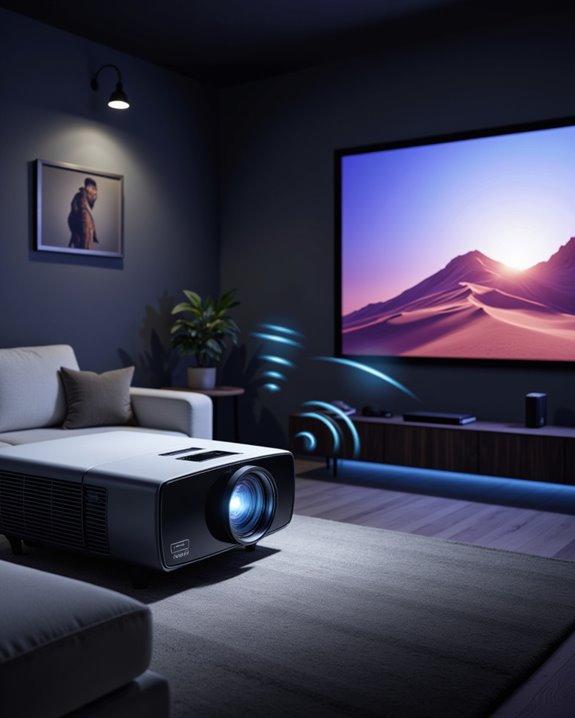
WiFi-enabled projectors deliver numerous advantages that transform how users experience home entertainment and business presentations. These devices enable personalized viewing through wireless connectivity, allowing seamless streaming from multiple devices without cable clutter. Users gain enhanced content management capabilities, accessing platforms like Netflix and YouTube directly through built-in apps. Modern wireless projectors utilize built-in WiFi networks to connect directly with smartphones and tablets for instant content sharing. The wireless transmission also reduces setup time and makes repositioning the projector more flexible, accommodating various room layouts.
The wireless functionality extends beyond basic streaming, offering smart features such as automatic screen adjustment and remote control through mobile apps. Integration with home automation systems enables voice commands and scheduled operations. Users can also benefit from wireless audio options, connecting to Bluetooth speakers or headphones for improved sound quality. The elimination of physical cables provides greater flexibility in projector placement while maintaining high-quality 4K resolution capabilities and reliable signal transmission.
Streaming Capabilities and Smart Features
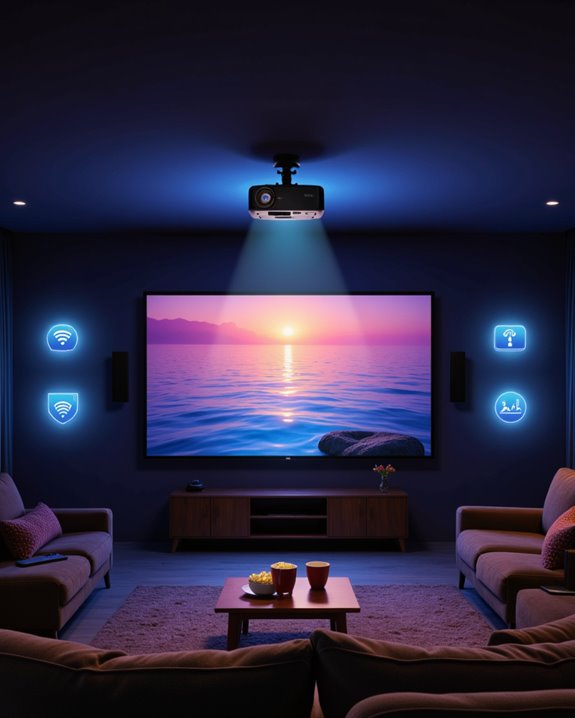
Building upon the wireless functionality advantages, streaming capabilities and smart features represent the core appeal of today’s WiFi projectors. Modern projectors incorporate Android-based systems that enable direct access to streaming services like Netflix and Hulu, while supporting wireless gaming through seamless device connectivity. These smart features include automatic screen calibration and voice control capabilities for enhanced user convenience. Leading models like the LG CineBeam HU70LA deliver stunning visuals with wide color gamut technology and webOS integration. Many WiFi projectors come equipped with built-in app stores, allowing users to expand their entertainment options beyond traditional streaming services. The integration of advanced operating systems enables automatic updates and smart home compatibility. With support for wireless casting technologies like Chromecast and AirPlay, users can easily mirror content from smartphones and tablets. Additionally, high-resolution capabilities up to 4K ensure superior image quality for streaming content, and some models offer software update management to keep features current and secure.
Alternative Connection Methods for Projectors
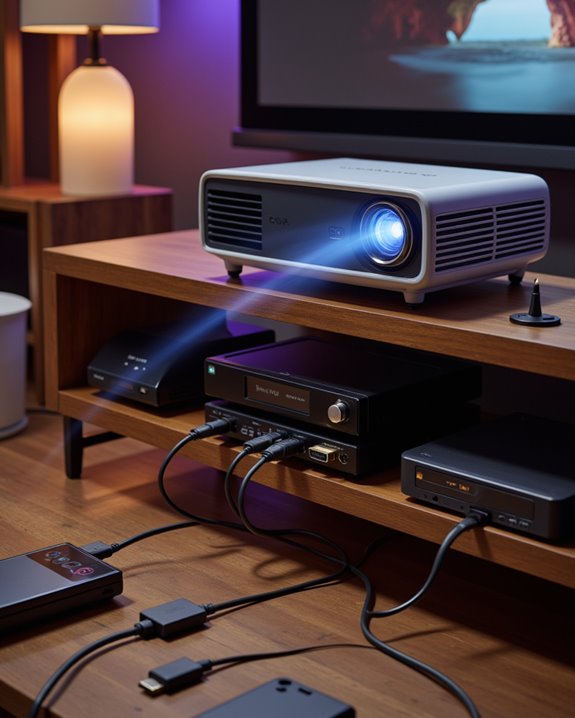
A robust selection of alternative connection methods exists for projectors beyond WiFi functionality, guaranteeing users can display content even without wireless internet access. Traditional HDMI cables provide reliable, high-quality video transmission, while USB-C adapters offer modern connectivity solutions with simplified cable management. For under $30, users can purchase Wi-Fi dongles that plug directly into HDMI ports for wireless streaming capabilities.
For wireless gaming and content streaming without internet, technologies like Miracast and AirPlay enable direct device-to-projector connections. Users can also utilize USB drives or external hard drives for offline content playback. Smart projectors often include built-in features like Chromecast, expanding connection possibilities without additional hardware.
Legacy options remain available for older equipment, including VGA cables and composite connections. These alternatives ensure compatibility across different devices and scenarios, making projectors versatile display solutions regardless of internet availability.
Setting Up Your WiFi Projector for Optimal Performance
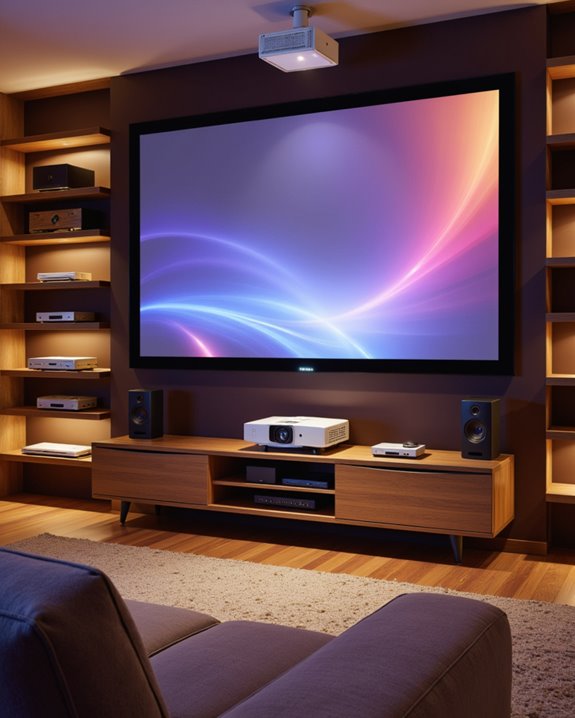
While establishing a reliable wireless connection forms the foundation of projector setup, proper configuration requires careful attention to both network and physical positioning details. Initial projector calibration involves accessing Wi-Fi settings through the remote control functionality and carefully entering network credentials. Users should position the device within effective range of their router, minimizing physical obstacles that could weaken the signal. For optimal viewing quality and brightness, projectors requiring more than 3,000 lumens are recommended for rooms with significant ambient light.
For *best* performance, operators need to:
- Update the projector’s firmware regularly
- Adjust network protocols when necessary
- Test signal strength in various locations
- Configure screen alignment precisely
If connection issues arise, users should methodically troubleshoot by checking password accuracy, restarting devices, or relocating the projector closer to the router. Advanced settings like IP configuration may require consultation of the user manual for model-specific instructions.
Comparing Wifi Vs Non-Wifi Projector Models
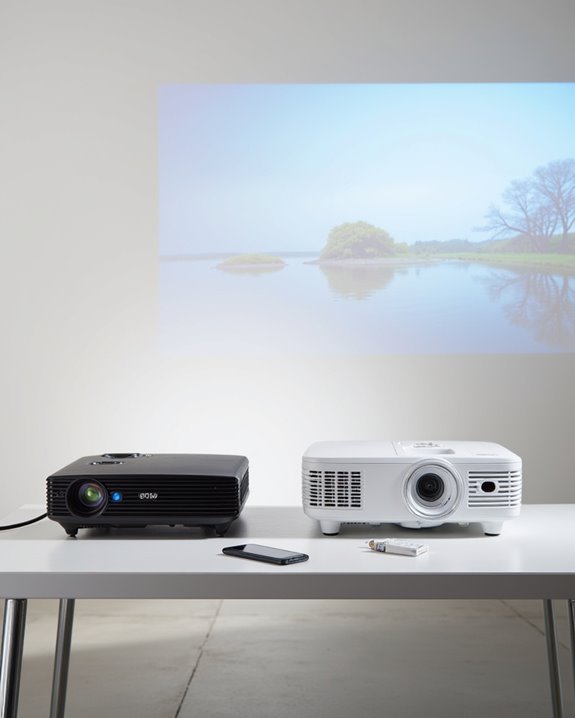
The fundamental divide between WiFi and non-WiFi projectors centers on their connectivity capabilities and built-in features. WiFi-enabled models offer wireless streaming and device casting, while non-WiFi projectors rely on physical connections like HDMI and USB ports. Battery life tends to be similar between both types, as wireless functionality typically consumes minimal power. Smart projectors enhance the viewing experience with built-in streaming apps that eliminate the need for additional devices.
The key differences emerge in their functionality and cost. WiFi projectors often include remote control features through smartphone apps, enabling easier navigation and settings adjustment. However, they typically cost more than their non-WiFi counterparts. Non-WiFi projectors excel in environments where internet access isn’t necessary, offering reliable performance through direct connections. When streaming services are essential, WiFi projectors provide convenient access, though some may require additional hardware to bypass copyright restrictions.
Essential Features to Consider When Buying a Projector
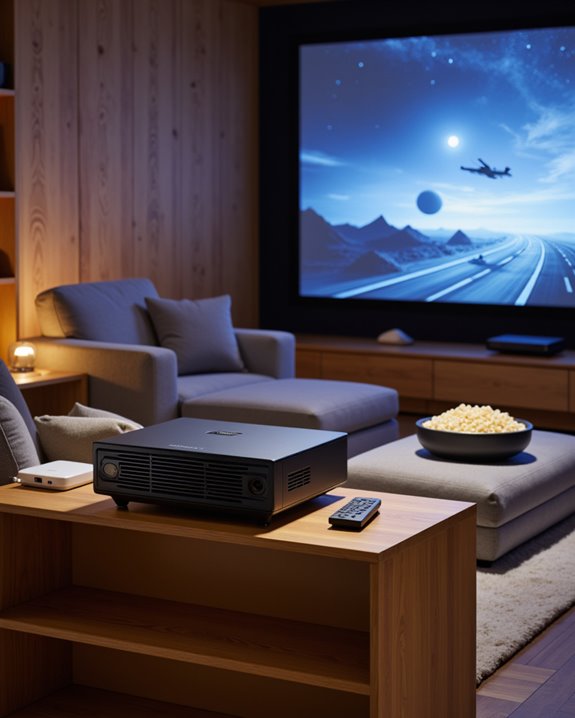
Understanding projector features helps buyers make informed decisions that align with their specific needs. Key considerations include resolution, contrast ratio, and connectivity options. Resolution determines image sharpness, with 4K offering superior quality for precise projector mounting and screen calibration.
Contrast ratio and color saturation impact image depth and vibrancy, particularly in home theater environments. Modern LED projectors deliver wide color gamut capabilities for enhanced visual quality. Modern projectors offer multiple connection types, from HDMI to wireless capabilities. Throw distance, which affects image size based on room dimensions, requires careful calculation for optimal placement.
Brightness, measured in lumens, determines performance in various lighting conditions. While LED and laser models provide energy efficiency, traditional lamp projectors remain common. The selection process should prioritize features that match the intended viewing environment and content type.
Making the Right Choice for Your Home Theater Setup
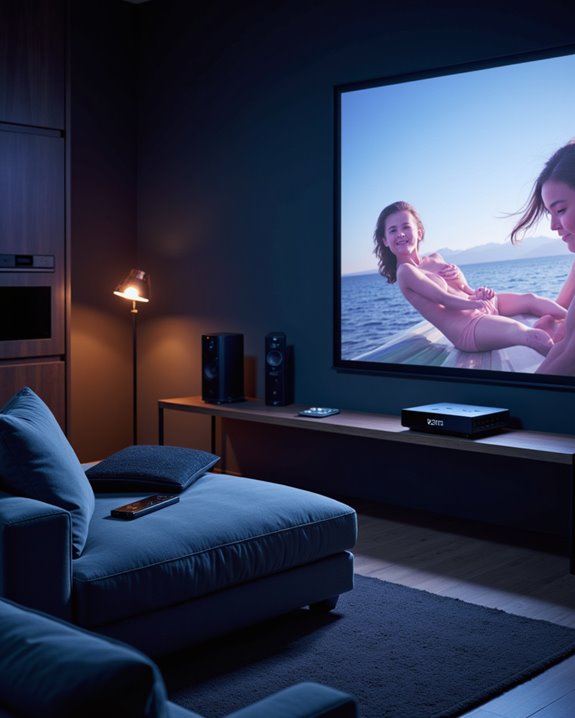
Creating an effective home theater setup requires careful consideration of multiple interconnected elements that work together to deliver an immersive viewing experience. The process begins with determining the appropriate screen size for the room dimensions and selecting a projector with suitable brightness and resolution capabilities. Fixed screens provide superior viewing quality and minimize installation challenges compared to retractable options.
Sound quality plays a vital role in the overall experience, requiring strategic placement of speakers and proper acoustic treatment. The setup should include:
- A screen material that matches the projector’s specifications
- Adequate light control through blinds or curtains
- Comfortable seating positioned at ideal viewing angles
- Well-organized cable management systems
The room’s layout should accommodate both the technical requirements of the equipment and the practical needs of viewers. Proper mounting and installation ensure stability, while careful calibration of both video and audio components maximizes performance.
Frequently Asked Questions
Can Wifi Projectors Work in Areas With No Internet Connection?
WiFi projectors can operate in areas without internet through offline viewing options and wired connectivity methods. Users can connect devices via HDMI, USB ports, or utilize internal storage for displaying locally stored content.
How Much Data Does Streaming Through a Wifi Projector Consume?
4K streaming consumes up to 10GB per hour through a WiFi projector. Data usage varies markedly based on streaming quality, with HD content using 1-3GB hourly and standard definition requiring considerably less bandwidth.
Do Wifi Projectors Drain Batteries Faster Than Non-Wifi Models?
WiFi projectors typically drain batteries faster than non-WiFi models due to increased power consumption. Battery life is especially shorter when wireless connectivity is active, with WiFi-enabled models generally lasting 2-2.5 hours versus 4 hours for non-WiFi versions.
Can Multiple Devices Connect to a Wifi Projector Simultaneously?
Most Wi-Fi projectors support up to 50 connected devices simultaneously, though only 4 can typically display content at once. Device compatibility and signal strength affect performance across different platforms sharing screen space.
Will a Wifi Projector Interfere With Other Wireless Devices Nearby?
WiFi projectors can contribute to wireless interference in crowded networks, potentially affecting signal stability of nearby devices. However, proper channel selection and device placement can minimize these impacts on other wireless equipment.


